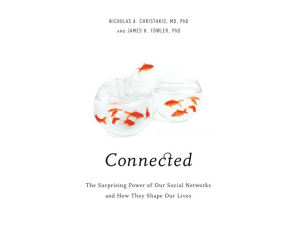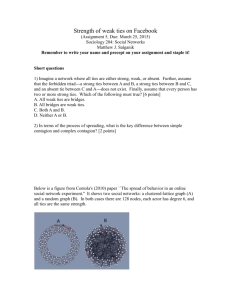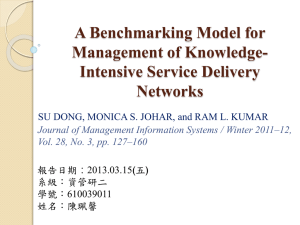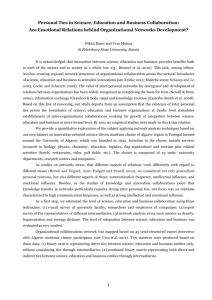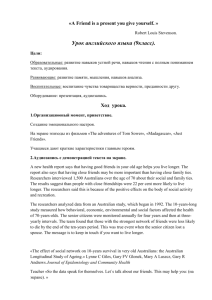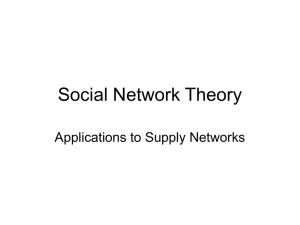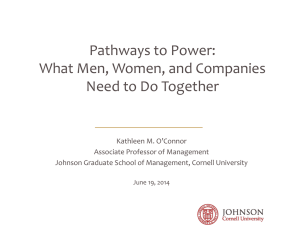EncyclopediaofCommunity
advertisement
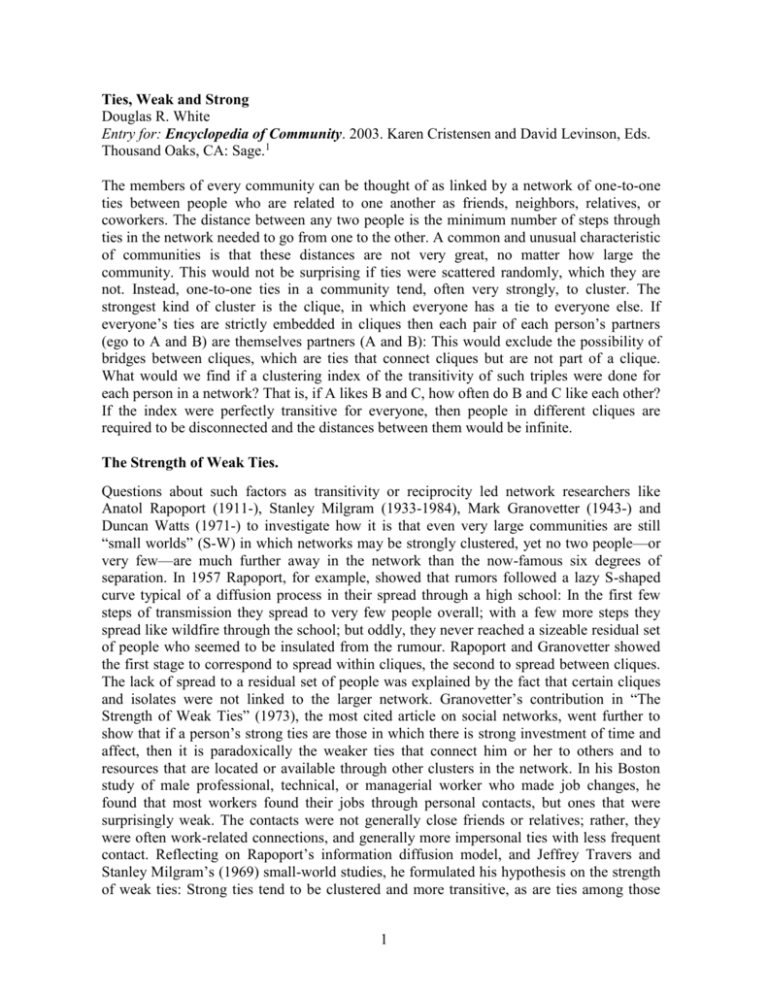
Ties, Weak and Strong Douglas R. White Entry for: Encyclopedia of Community. 2003. Karen Cristensen and David Levinson, Eds. Thousand Oaks, CA: Sage.1 The members of every community can be thought of as linked by a network of one-to-one ties between people who are related to one another as friends, neighbors, relatives, or coworkers. The distance between any two people is the minimum number of steps through ties in the network needed to go from one to the other. A common and unusual characteristic of communities is that these distances are not very great, no matter how large the community. This would not be surprising if ties were scattered randomly, which they are not. Instead, one-to-one ties in a community tend, often very strongly, to cluster. The strongest kind of cluster is the clique, in which everyone has a tie to everyone else. If everyone’s ties are strictly embedded in cliques then each pair of each person’s partners (ego to A and B) are themselves partners (A and B): This would exclude the possibility of bridges between cliques, which are ties that connect cliques but are not part of a clique. What would we find if a clustering index of the transitivity of such triples were done for each person in a network? That is, if A likes B and C, how often do B and C like each other? If the index were perfectly transitive for everyone, then people in different cliques are required to be disconnected and the distances between them would be infinite. The Strength of Weak Ties. Questions about such factors as transitivity or reciprocity led network researchers like Anatol Rapoport (1911-), Stanley Milgram (1933-1984), Mark Granovetter (1943-) and Duncan Watts (1971-) to investigate how it is that even very large communities are still “small worlds” (S-W) in which networks may be strongly clustered, yet no two people—or very few—are much further away in the network than the now-famous six degrees of separation. In 1957 Rapoport, for example, showed that rumors followed a lazy S-shaped curve typical of a diffusion process in their spread through a high school: In the first few steps of transmission they spread to very few people overall; with a few more steps they spread like wildfire through the school; but oddly, they never reached a sizeable residual set of people who seemed to be insulated from the rumour. Rapoport and Granovetter showed the first stage to correspond to spread within cliques, the second to spread between cliques. The lack of spread to a residual set of people was explained by the fact that certain cliques and isolates were not linked to the larger network. Granovetter’s contribution in “The Strength of Weak Ties” (1973), the most cited article on social networks, went further to show that if a person’s strong ties are those in which there is strong investment of time and affect, then it is paradoxically the weaker ties that connect him or her to others and to resources that are located or available through other clusters in the network. In his Boston study of male professional, technical, or managerial worker who made job changes, he found that most workers found their jobs through personal contacts, but ones that were surprisingly weak. The contacts were not generally close friends or relatives; rather, they were often work-related connections, and generally more impersonal ties with less frequent contact. Reflecting on Rapoport’s information diffusion model, and Jeffrey Travers and Stanley Milgram’s (1969) small-world studies, he formulated his hypothesis on the strength of weak ties: Strong ties tend to be clustered and more transitive, as are ties among those 1 within the same clique, who are likely have the same information about jobs and less likely to have new information passed along from distant parts of the network. Bridges between clusters tend to be weak ties, and strong ties are less likely to be bridges. Hence acquaintances are more likely to pass job information than close friends, and the acquaintances of strategic importance are those whose ties serve as bridges in the network. The Search for an Abortionist, a 1969 work by Nancy Howell (at that time Nancy Lee), showed that women acquired scarce information in a similar fashion—through short chains of weak ties. Of the many later studies, some found that weak ties are more important in the search for scarce than for plentiful resources: Only in times of plenty are close associates likely to have access to what you need. Granovetter’s arguments against the economists’ models of rationality in decision making, however, are still among the most persuasive for the general importance of social networks. He asserted that choices are not a matter of making optimal decisions among alternatives given perfect information: What information and what choices people have are affected by their network placement. Duncan Watts and Steven Strogatz (1998) and Watts (1999) revisited the S-W model of large communities in such diverse contexts as the World Wide Web, scientific communities, and degrees of separation among actors, and provoked a second wave of network studies, across multiple disciplines. They showed how bridge ties, seeded randomly in strongly clustered networks, serve as shortcuts to otherwise distant points in the networks, and that the S-W property of clustering and short average distances in a network is highly robust under wide variations in the ratio of weak or random ties to those in clusters. In 1999 Jon Kleinberg investigated how individuals can find short chains to specific others in a large social network. His computer-based experiment was to space the nodes of a network at regular intervals in a two or three dimensional grid, and then to generate the ties in the network according to a probability that varies inversely with spatial distance, or distance raised to some power, such as distance squared. A typical person, represented as a node, could try to pass a message to a target at a known location through a tie to the node that was closest to the target. His criterion for a searchable network was that it was possible to reach the target in a reasonable number of steps. He showed that not all S-W networks are searchable. Searchability depended on an appropriate balance between clusters and bridges: When the decay of ties with distance is given too little weight, local clusters fade away as the network becomes more random. Unsearchablility sets in very quickly with too much randomness because the next closest node may be even further away than the current location. Local clustering, then, hones on the target once the search is in the vicinity. Conversely, when ties decay too rapidly with distance, and local clusters are too dense, too many tiny steps of traversal result and the shorter paths are rarely found. Searchability is thus a property of S-W networks that is quite fragile, and depends on a rate of network distance decay that matches the kinds of cues that make navigation possible. Small worlds with searchability, although fragile, offer an important capability for distributed intelligence that many researchers are finding in varying degrees not only in human communities but in communities of all types, such as ecological and biological ones. In 2002 Watts, Peter Dodds and Mark Newman developed a further set of models that show how the effectiveness of searches for nodes in informational networks such as the World Wide Web or in social networks depends on how clusters and bridges are constructed in relation to how they are known and identified. Bridge ties must have a greater likelihood 2 of bringing a search close to a target early on, while in the final stages of the search clustered ties must be able to close in on a target. In their models, searches based on multiple and cross-cutting identities of nodes—such as occupations on the one hand and spatial locations on the other—help to find shortcuts that bring a search closer to a target. Their models fit with the results of Milgram’s original S-W experiment, which investigated whether people randomly selected in Omaha, Nebraska, could succeed in sending letters to a target in Boston when asked to direct their letters to single acquaintances, who are asked in turn to forward the letters through what will become a chain of personal acquaintances. Successful chains depended on finding intermediate links through commonalities shared with the target, such as occupation or region. Dodds, Roby Muhamad and Watts’ 2002 S-W experiment on 67,000 e-mail users and 18 targets in 13 countries estimated a true median distance to targets of six steps, mostly using ties of intermediate—not weak—ties. Geography accounted for 50 percent of ties in the first three steps, with under 33 percent of ties being through work or occupation; those percentages were reversed of these percentages in steps four through seven. Communities as Cohesive Clusters of Strong versus Weak Ties Looser notions of community clusters, and of how clustered versus bridging ties can be identified, have also been introduced and studied in relation to strong and weak ties. Douglas White and Frank Harary developed ways to define cohesive hierarchies in networks on the assumption that patterns of cohesion in one-to-one ties reveal community (or network) boundaries. They draw on findings in Harary’s 1969 book on Graph Theory showing that the smallest number of network elements whose removal will disconnect a pair of nodes in a network is equivalent to the number of distinct paths between them, and that for every number up to some largest number k there will be cohesive components of a network that form cohesive hierarchies. Components corresponding to the largest such number are the most cohesive: They may identify small highly cohesive subgroups such as cliques while those corresponding to lower numbers may identify the larger communities. Hypotheses about cohesive subgroups with well defined boundaries at each level in a cohesive hierarchy may thus be tested operationally. Granovetter’s hypothesis, for example, would predict that the ties linking the broader community include weaker ties, while strong ties are more likely to be found in subgroups with higher levels of cohesion. Most ties in a community network may be weak but still cohesive, as Granovetter found for Boston’s West End. White and Houseman find, in contrast, that that there also exist small world communities composed of strong ties that have the properties of searchability identified by Kleinberg and by Dodds, Muhamad and Watts. The theory that a large-scale cluster of one-to-one ties defines a natural community is also used by Michelle Girvan and Newman to show how clusters composed of nonbridging ties can serve to identify the communities in a network. Other researchers have shown that at the margins of communities, leading to problems of resource distribution and diffusion of information, are those whose ties do not cohere to a larger group, or who are systematically excluded by those with whom their ties are weak. Benefits of community and collective intelligence are strengthened by attention to integration at the margins. Research Directions 3 There are many interesting open questions in this field of research on S-W and community network configurations and their social effects, how the strength or weakness of ties in Granovetter’s sense are related to them, and how to integrate new findings in relation to broader social theory. Are individuals or ties the binding elements in social cohesion? Are they of equal significance or is there asymmetry in the roles of individuals versus ties in social networks? What are the effects of asymmetries between retraction of ties in a network versus the withdrawal of individuals, and the ways that each may disconnect a subgroup? How do these questions play out in networks constructed either of one-to-one links, intersections of memberships in groups, or, as in studies of community by Mische and Pattison, of intersections of memberships plus one-to-one links between members in different groups? Is it the bundles of bridging ties or the sets of individuals with multiple memberships that are significant in shrinking the distances in a community network so as to form a small world? Raising questions such as these in the context of network research was one of the original contributions of the strength of weak ties argument. Further Reading Dodds, Peter S., Roby Muhamad and Duncan J. Watts (Submitted 2002). An Experimental Study of Social Search and the Small World Problem. Nature … Girvan, Michelle, and Mark E. J. Newman (2002). Community Structure in Social and Biological Networks. Proceedings of the National Academy of Science. USA 99: 8271-76. Granovetter, Mark (1973). The Strength of Weak Ties. American Journal of Sociology 78:1360-80. Harary, Frank (1969). Graph Theory. Reading, MA: Addison-Wesley. Lee, Nancy (1969). The Search for an Abortionist. Chicago: University of Chicago Press Kleinberg, Jon (2000). Navigation in a Small World. Nature 406:845. Mische, Ann, and Phillipa E. Pattison (2000). Composing a Civic Arena: publics, projects and social settings. Poetics 27:163-194. Rapoport, Anatol (1957). A Contribution to the Theory of Random and Biased Nets. Bulletin of Mathematical Biophysics 19, 257-271. Travers, Jeffrey, and Stanley Milgram (1969). An Experimental Study of the Small World Problem. Sociometry 32:425-443. Watts, Duncan J. 1999. Small Worlds: The Dynamics of Networks Between Order and Randomness. Princeton, NJ: Princeton University Press. Watts, Duncan J., and Steven Strogatz (1998). Collective Dynamics of ‘Small-World’ Networks. Nature 393:440-442. Watts, Duncan J., Peter S. Dodds and Mark E. J. Newman (2002). Identity and Search in Social Networks. Science 296:1302-1305. White, Douglas R., and Frank Harary. 2001. The Cohesiveness of Blocks in Social Networks: Connectivity and Conditional Density. Sociological Methodology 2001 vol. 31:305-359. Boston: Blackwell Publishers. White, Douglas R., and Michael Houseman. 2002. The Navigability of Strong Ties: Small Worlds, Tie Strength and Network Topology. Complexity 7(6). December issue. 1 Thanks to Mark Granovetter and Duncan Watts for helpful corrections, clarifications and suggestions. 4
